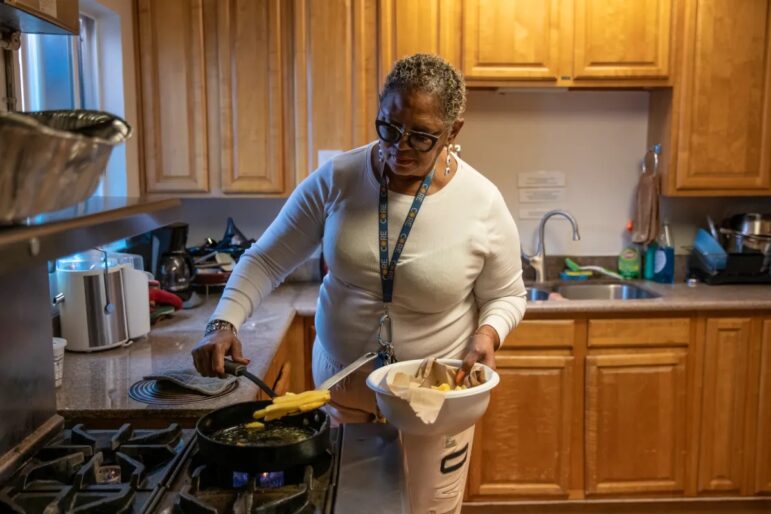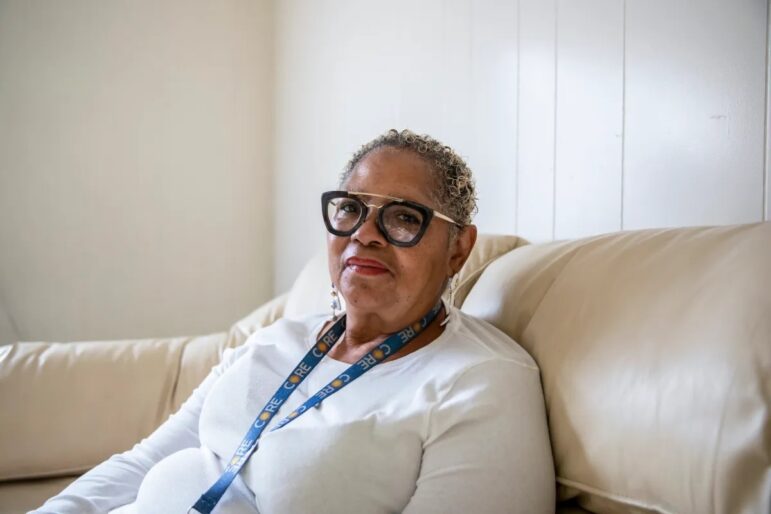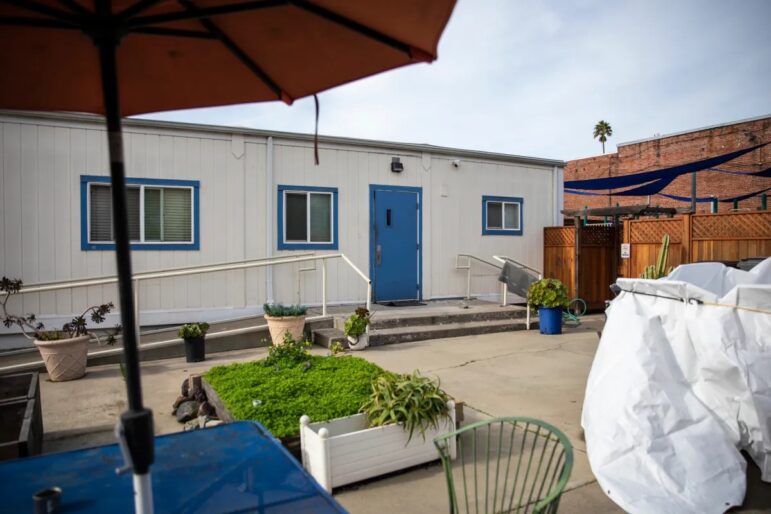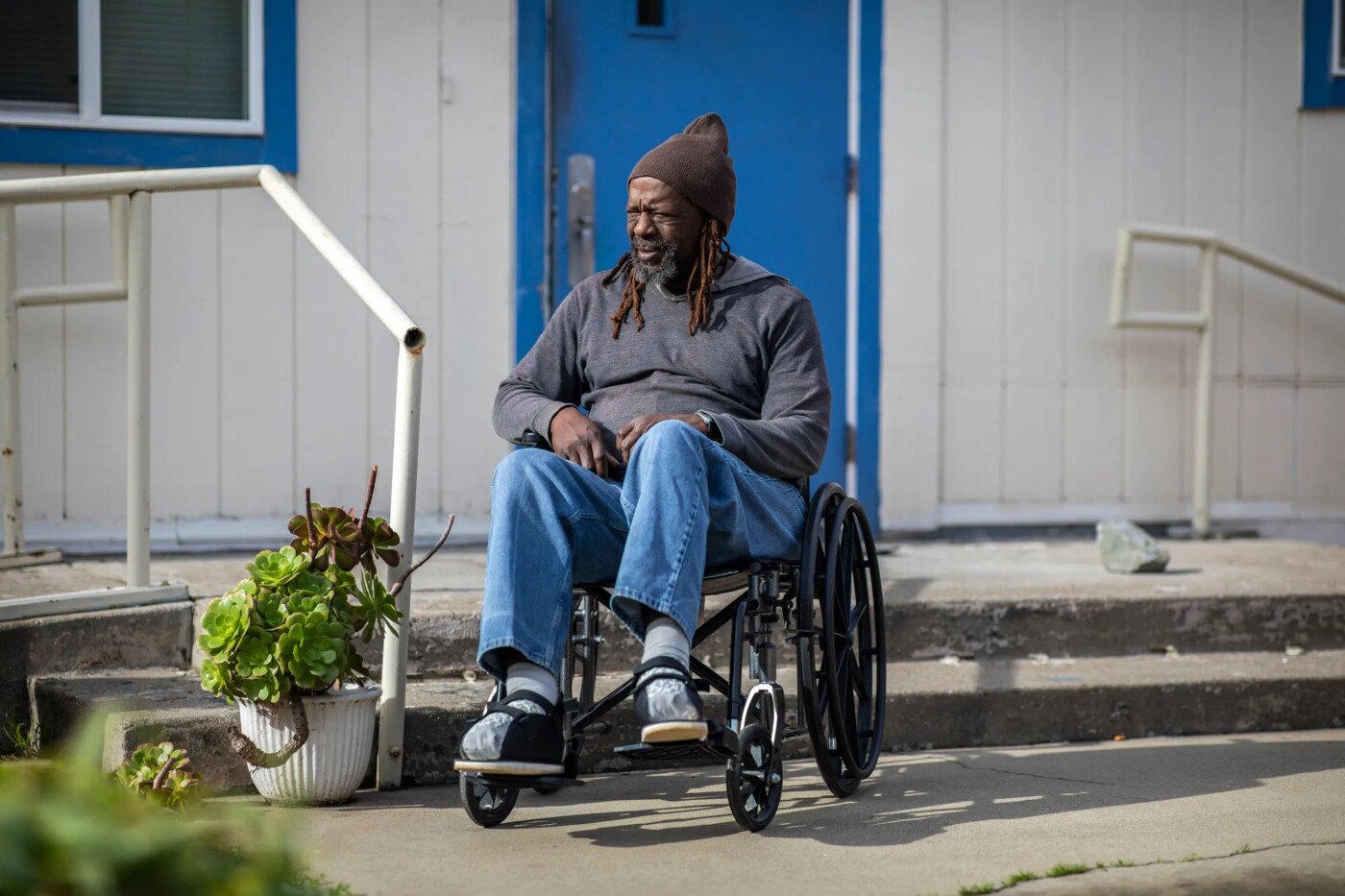Norma Johnson cracks a faint smile as she adjusts her stylish cat-eye glasses.
She’s at St. Mary’s Center’s cafeteria in West Oakland, where older adults in interim housing or living on the streets can drop by for a free meal. But Johnson’s mind is elsewhere. Her treasured red leather rocking chair, along with most of her belongings, sits in a storage unit. She’s afraid if she doesn’t pay her $500 balance soon, the storage unit operator will auction everything.
“I gotta pull a rabbit out of my hat,” Johnson, 65, said during a rainy January day. “I don’t want to lose the things I do have. I don’t have a house, and now I won’t have,” she hangs her head before finishing that sentence.
Unexpectedly, Johnson finds herself in the middle of a budding crisis: aging without a home.
California accounts for about a third of the nation’s homeless people, and among this population, seniors are estimated to be the fastest-growing group. One key indicator is the state’s tally of people accessing homelessness services.
From 2017 to 2021, California’s overall senior population grew by 7% but the number of people 55 and over who sought homelessness services increased 84% — more than any other age group — according to the state’s Homeless Data Integration System.
For comparison, the number of people accessing homelessness services across all ages increased 43% during this time period.
Elderly people who are homeless include those who have been unhoused for a long time and are getting older. But they also include those who are part of a growing trend, research shows: people experiencing homelessness for the first time after age 50.

Those at increased risk of losing shelter tend to be older adults who live alone and on fixed incomes, with little to no savings. A main contributor, experts say, is that as California rents soar, seniors’ income streams, including Social Security benefits and Supplemental Security Income, have not kept up.
Black Californians have long been overrepresented in the unhoused population — representing about 6% of the state’s population but close to 30% of those accessing homelessness services, state data show.
“For many of us, there’s a picture in our mind connected to substance abuse or mental health issues. And for maybe a quarter of people who are currently unhoused, that is a cause. But most people becoming homeless today do so for economic reasons,” said Sharon Cornu, executive director at St. Mary’s Center, a nonprofit group that operates several services for older adults, including transitional housing.
“As someone in this age group, I can tell you, it’s remarkable to think about; you’ve kept yourself employed and housed and above water this whole time period, and in what ought to be golden years, here you are out on the street,” she said.
Just last summer, Johnson was living in a three-bedroom house she shared with a housemate and working at a COVID-19 testing site. But her situation changed suddenly. She had to stop working to undergo surgery for an old back injury. Then her housemate of almost three years moved out, leaving Johnson on the hook for the full $2,500 rent that she could not afford on her own.
After she lost her place, Johnson was referred to St. Mary’s Center, where she currently shares a trailer with five other people. Everyone who stays at St. Mary’s transitional housing units is 55 or older and many have bounced from the streets to shelters to living in cars or staying with relatives. Here, they have access to a case manager. The goal is to link them to any health and social services they may need and help them find permanent affordable housing.
Respite at St. Mary’s Center
Stories like Johnson’s are common among people who have been through St. Mary’s Center — barely making ends meet, an injury or stint of bad health having forced them to leave jobs sooner than they had hoped. In some cases, the death of a loved one, family conflicts, or abusive relationships left people without a place to stay.
Others, like Elbert Lee Jones Jr., spent decades on the streets. Born in Germany to a military family, he and his family moved to Oakland when he was 5 years old. As a young adult, he worked in fast-food restaurants, laundromats, and convenience stores.
“I had jobs, had a life, until cocaine came knocking on the door. It came knocking on the door and really messed up a whole lot,” Jones said.
Strong and mostly healthy, he managed on the streets for a long time. Then about three years ago, he woke up in his tent to foot pain so unbearable he could barely stand. An ambulance took him to the closest emergency room, where doctors told him he had gangrene on his toes; they would have to amputate all of them.
“They said ‘If you hadn’t come in when you did, you’da been dead,’” Jones said. “That was the darkest part of my life right there.”
After some time healing at a nursing home, he was back on the streets. In a wheelchair and about to turn 60, his situation was getting more complicated. So when the clinical director at St. Mary’s Center approached Jones under a freeway overpass last year and offered him a place to stay, he accepted. He was reluctant at first, he said. It had been a long time since he’d trusted anyone.
On the streets, 50 is the new 70
Research has shown that living on the streets — eating and sleeping poorly, being exposed to the elements, not getting proper medical care and losing medication during encampment sweeps — will prematurely age, sicken, and kill people. That is why when speaking about the homeless population, advocates and experts often refer to “seniors” as anyone 50 and above.
By the time homeless people are in their 50s and early 60s, they look much more like other people in their 70s and 80s, said Dr. Margot Kushel, director of UC San Francisco’s Benioff Homelessness and Housing Initiative.
“Everything is shifted back about 20 years,” Kushel said. “The health problems that we normally associate with aging — vision problems, hearing problems, cognitive impairments, difficulty bathing, difficulty walking — all of those things start much younger.”
Their situation could also trigger anxiety, depression, and substance use.
Recently, the state launched incentives for Medi-Cal providers, who serve low-income patients, to start and grow street medicine programs. Historically, most of these programs have been funded by philanthropic groups and foundations. And perhaps now more than ever, these programs play a crucial role, but in limited numbers they can only do so much for this medically needy population. Routine care and timely diagnosis are more difficult when people are moving from one encampment or shelter to another.
And simply put, “There is no medicine as powerful as housing,” Kushel said.
Researchers for one UCSF study published last summer followed homeless people 50 and older over eight years in Oakland and found they were 3.5 times more likely to die early compared to other seniors in the city. In the study, the median age of death was 64.6 years old, compared to 76.1 years for all Americans. The main causes of death for the unhoused were heart disease, cancer, and drug overdose.
The health needs of seniors can be complex. And most shelters are not equipped to serve a geriatric population. Programs that serve seniors specifically, like the one at St. Mary’s Center, are few and far between.
Across the state, shelters are being overwhelmed by unhoused people who need more than these facilities can provide. For example, ideally, shelters would have a nurse on site, but that could cost about $90,000 a year per nurse, which most facilities wouldn’t be able to afford, said Sara Mirhadi, chief program officer at Poverello House, which provides food, shelter and social services to homeless people in downtown Fresno.
In the past several years, her shelter’s population has gotten older and their disabilities have increased. A number of those who come in regularly are in wheelchairs and need help using the bathroom. When you add conditions such as dementia and mental health issues, caring for this population becomes even more challenging, Mirhadi said.
“At this point, I feel like our shelters are slowly becoming de facto nursing facilities,” she said. “I've had to ask staff to do a lot of things that they normally wouldn't do.”
The Fresno-Madera region has seen one of the biggest jumps in homelessness among the 55- and-older population, increasing 216% from 2017 to 2021, state data shows. Coincidentally or not, rents and home prices in the Fresno area have skyrocketed in recent years. Other areas that saw more than a two-fold increase in homelessness among this age group include the Yuba-Sutter area, and Yolo, San Francisco, Merced, and Alameda counties. (Homeless data is tracked by regional agencies whose territories can include a single city or several counties.)
“I think we need to really take a hard look at what we're doing for our elderly population, because they should not be in a shelter,” Mirhadi added.
Making a dent in homelessness
In January 2021, Gov. Gavin Newsom released California’s Master Plan for Aging, a 10-year blueprint on how to better prepare the state for a graying population — a quarter of the state’s residents will be 60 or older by 2030. The rollout of this plan also comes at a time when an estimated 2 million seniors are considered economically insecure, struggling to afford rising rents and health care costs.

The No. 1 priority in that master plan is increasing affordable housing options for seniors, allowing them to age in place. The plan lays out goals and initiatives that legislators and the administration can pursue over time.
“Once homeless, older individuals face really unique barriers that make it extremely difficult for them to get housed again, so putting the emphasis on homeless prevention and making that a front and center strategy of dealing with older adult homelessness is something that we are seeing more attention paid to,” said Patti Prunhuber, director of housing advocacy at Justice in Aging, a legal advocacy group focused on senior poverty.
One proposal Prunhuber and other advocates are pushing for this year is Senate Bill 37, carried by Sen. Anna Caballero, a Merced Democrat, that would create a state-run housing subsidy program for elderly people and those with disabilities at highest risk of becoming homeless. A similar bill died in the legislature last year after it failed to receive funding in the state budget.
A state subsidy program would supplement federal assistance programs — such as Section 8 vouchers — that help about 10.2 million Americans with “extremely low incomes” afford rent. With demand outpacing supply, only about 4 out of every 10 people eligible for a federal rental subsidy receive it, said Sharon Rapport, California policy director for the Corporation for Supportive Housing, a nonprofit organization that advocates for homelessness prevention and a sponsor of the bill.
The goal of a state program would be to help people obtain federal rental vouchers, but in the meantime provide state-funded help. This way, more older adults will be able to stay in their current homes, she said.

“The state should be in this business too because the feds alone can't solve homelessness and the state alone can't solve homelessness,” Rapport said. “But they can make a big dent in it and eventually solve it if they're both putting in resources toward programs that work.”
With the help of housing navigators at St. Mary’s Center, Jones has spent the last eight months filling out applications for subsidized housing. If everything goes as planned, he expects to have his own studio apartment in Oakland by the end of this month.
It’ll be a far cry from his 20-plus years on the streets, he said.
He has a vision for his place: “I want it to be homey, warm. A place you could be comfortable in,” he said. “I’m going to have pictures up on the walls. I’ve got a green thumb. I’m going to have plants. It's gonna be nice.”
Johnson said she, too, dreams of having a place to call her own again.
“I don't want to have to worry about people leaving me behind with the whole amount of the rent,” she said. “I don't want to do that anymore.”
